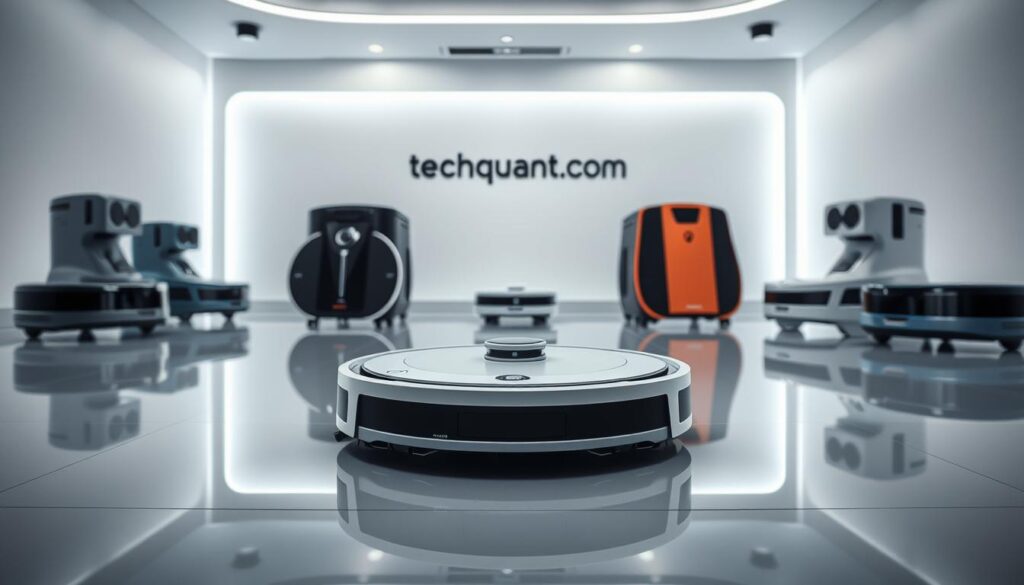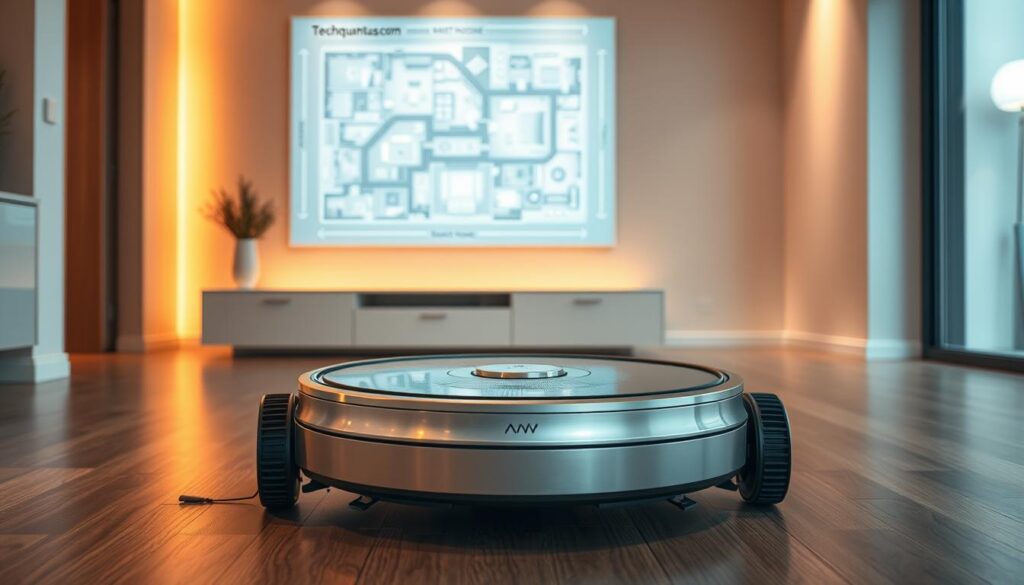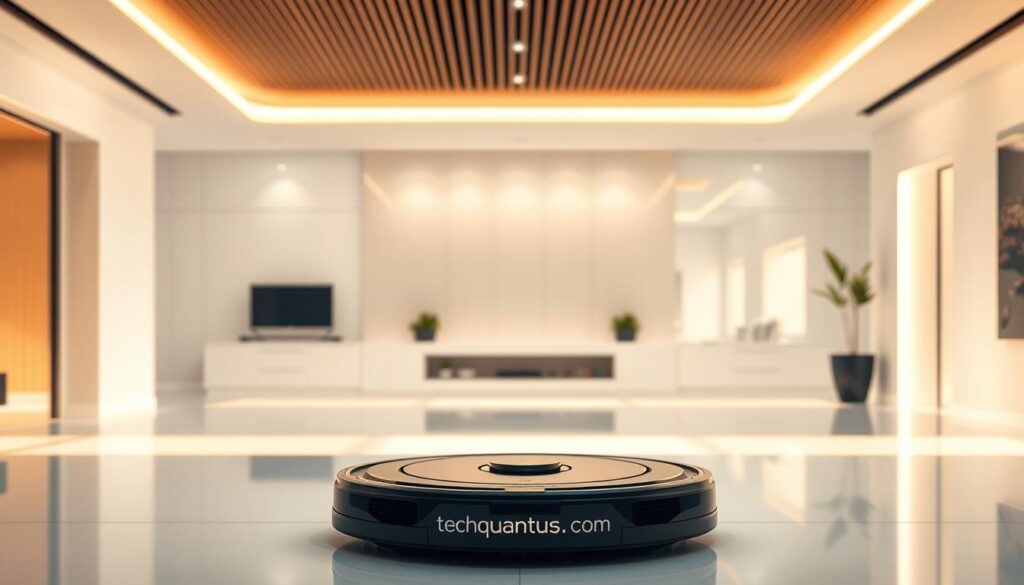Are you tired of spending hours cleaning your home? A small intelligent device can do it for you. Robot vacuums have changed home cleaning, making it easier with smart home tech.
In 2025, robot vacuums are key smart home helpers. They move around your home, picking up dust, pet hair, and more. They use advanced sensors and mapping to clean rooms well, fitting different floors and layouts.
I’ve seen robot vacuums grow from simple cleaners to smart home devices. Today, they work with voice assistants, apps, and home systems. They’re more than just cleaning tools.
Key Takeaways
- Robot vacuums offer hands-free cleaning solutions
- Advanced navigation systems improve cleaning efficiency
- Smart home integration enhances user experience
- Modern devices handle multiple floor types
- Significant time-saving compared to traditional cleaning methods
Understanding Smart Home Robot Vacuums
Robot vacuums have changed the game in smart home cleaning. They bring convenience and tech to your floors. These devices use advanced sensors, strong suction, and smart paths.
Today’s robot vacuums are more than just cleaners. They map your space, dodge things, and work with other smart home gadgets.
Key Features of Modern Robot Vacuums
Modern robot vacuums have amazing features:
- Advanced mapping and navigation technologies
- High-efficiency particulate air (HEPA) filtration systems
- Multi-surface cleaning capabilities
- Smartphone app integration
- Voice command compatibility
How Navigation Systems Work
Navigation is key for a good robot vacuum. Most use LIDAR or cameras to map your home. These help the vacuum:
- See room layouts
- Avoid obstacles
- Plan cleaning routes
- Set off-limits areas
Battery Life and Charging Capabilities
Battery life has gotten better in robot vacuums. Many now last longer and charge smartly, so they’re always ready.
- Average runtime: 90-120 minutes
- Self-charging dock stations
- Quick charge capabilities
- Battery life indicators
Robot vacuums are great for daily cleaning but might need a regular vacuum for deep cleans. The tech keeps getting better, making these devices more useful and easy to use.
Premium Robot Vacuums for Ultimate Convenience
The world of robot vacuums has seen huge leaps in 2025. Amazon electronics have made home cleaning easier with top-notch robot vacuum tech. This tech brings unmatched convenience and performance.

I’ve looked into the best robot vacuums that are changing home maintenance. These advanced devices have smart features that go beyond usual cleaning.
Ecovacs Deebot X8 Pro Omni: Intelligent Cleaning Powerhouse
The Ecovacs Deebot X8 Pro Omni is a standout robot vacuum. It has amazing abilities:
- Advanced LiDAR navigation for precise room mapping
- Powerful suction delivering deep carpet cleaning
- Self-cleaning mop roller to prevent cross-contamination
- Comprehensive home cleaning solution
Roborock S8 Pro Ultra: Next-Generation Cleaning
The Roborock S8 Pro Ultra is the top of robot vacuum tech. It has impressive features:
- Dual-spinning mop system for thorough floor cleaning
- Automatic voice-activated cleaning zones
- Enhanced obstacle detection
- Seamless smart home integration
iRobot Roomba j9+: Smart Obstacle Management
The iRobot Roomba j9+ takes intelligent cleaning to a new level. It has:
- Advanced object recognition technology
- Automatic dirt disposal system
- Personalized cleaning recommendations
- Multi-surface adaptive cleaning
These top robot vacuums show how Amazon electronics are changing home cleaning. They offer unmatched convenience and efficiency.
Mid-Range Robot Vacuums for Every Budget
Finding the perfect robot vacuum doesn’t mean breaking the bank. In the mid-range price segment, you can find amazing Amazon electronics. They offer great cleaning without high costs.
When looking for a mid-range robot vacuum, some features are key. Look for models that mix smart tech with good cleaning. The best robot vacuum should have:
- Efficient mapping technologies
- Strong suction power
- Smartphone app integration
- Reliable battery performance
The Roborock Q5 Max+ is a top pick in this range. It has advanced navigation for precise cleaning. It also has app control and maps multiple floors, making cleaning easier.
For those watching their budget, mid-range robot vacuums are a great deal. They now come with features like obstacle detection and zone cleaning. These were once only found in more expensive models.
Smart cleaning doesn’t have to cost a fortune.
My top picks for mid-range robot vacuums focus on performance and ease of use. Spending between $300-$500 gets you a reliable cleaner. It makes keeping your home tidy easier.
Smart Navigation and Mapping Technologies
Robot vacuum technology has changed how we clean our homes. It uses advanced navigation systems for better cleaning. Now, robot vacuums can do more than just clean floors.

LIDAR vs Camera-Based Navigation
There are two main ways robot vacuums navigate:
- LIDAR (Light Detection and Ranging): Uses laser scanning to create precise room maps
- Camera-Based Navigation: Relies on visual mapping and object recognition
LIDAR works better in dark places, while camera-based systems are better in bright areas. Both help make cleaning smarter and more efficient.
Multi-Floor Mapping Capabilities
Today’s robot vacuums can map out multiple floors. They can:
- Store multiple floor plans
- Recognize different home levels automatically
- Create zone-specific cleaning strategies
Obstacle Avoidance Systems
Good navigation also means avoiding obstacles. Modern robot vacuums use AI to:
- Detect and navigate around furniture
- Avoid electrical cords
- Prevent potential collisions with household items
These smart systems make cleaning your home easy and effective.
Cleaning Performance and Suction Power
Choosing a robot vacuum means looking at its cleaning power first. The suction power shows how well it can clean different surfaces and types of dirt. Today’s robot vacuums can clean as well as traditional vacuums.
Several things affect how well a robot vacuum cleans:
- Suction power measured in pascals (Pa)
- Brush design and configuration
- Floor surface adaptability
- Debris pickup efficiency
Top robot vacuums clean many floor types very well. Hardwood, tile, and carpeted surfaces get a deep clean with new suction tech. Some models pick up to 90% of dirt, pet hair, and small particles in one go.
Tests show big differences in how well robot vacuums work. The best ones are great at:
- Edge cleaning precision
- Deep carpet penetration
- Pet hair removal
- Fine dust collection
When picking a robot vacuum, check its suction power. Basic models have 1500-2000 Pa, while top ones can go up to 5000 Pa or more. This means they clean better on various surfaces.
The right robot vacuum makes cleaning your home easy and stress-free.
Self-Emptying and Maintenance Features
Modern robot vacuums have changed home cleaning with new self-maintenance tech. These smart home devices make cleaning easier, saving you time and effort.
Auto-Empty Base Stations
New robot vacuums have auto-empty base stations that change cleaning at home. These stations collect dust and dirt from the robot’s bin. This means:
- You don’t have to do much
- Dust is removed safely
- Cleaning goes on longer
Filter Systems and Maintenance
Keeping your robot vacuum clean is key for it to work well. Today’s vacuums have filters that catch:
- Small dust particles
- Allergens
- Pet hair
Filters need to be changed often to keep air clean and vacuum working right.
Mop Functionality Options
Hybrid robot vacuums can now mop and vacuum at the same time. They offer a full cleaning solution. These smart devices can:
- Clean and mop in one go
- Adjust water flow automatically
- Clean their mop attachments
With these features, robot vacuums are key to modern smart homes. They bring unmatched cleaning ease.
Smart Home Integration and App Control
Modern robot vacuums have become more than just cleaning tools. They are now smart home companions. These advanced Amazon electronics work well with voice assistants like Alexa, Google Home, and Siri. This makes life easier for tech-savvy homeowners.
Smart home technology lets users control their robot vacuums easily. You can start or stop cleaning with voice commands or a mobile app. With just a few words or taps, you can:
- Start or pause cleaning cycles
- Set custom cleaning schedules
- Create virtual no-go zones
- Monitor real-time cleaning progress
Companion apps have gotten better, giving users detailed insights. These apps now offer zone-specific cleaning, mapping multiple floor plans, and tracking cleaning history. For example, Roborock’s app lets you control it precisely. But, users say you need to say the brand name clearly.
Voice assistant compatibility has made things even better. By linking your robot vacuum to Amazon Alexa or Google Assistant, you can start cleaning without moving. Just say, “Alexa, start cleaning,” and your device will get to work.
Best Value Options Under $500
Today, finding a top-notch robot vacuum that’s easy on the wallet is easy. The Amazon electronics market has many affordable options. These vacuums clean well without costing a lot.
Looking for a cheap robot vacuum? There are many great options. They offer great value for those watching their budget.
TP-Link Tapo RV30 Max Plus Features
The TP-Link Tapo RV30 Max Plus is a great deal. It has smart navigation and strong suction. It’s perfect for those who want efficiency without spending a lot.
- Advanced mapping technology
- Strong 3000Pa suction power
- Intelligent route planning
- App-controlled cleaning modes
Wyze Robot Vacuum Benefits
The Wyze Robot Vacuum is a great budget pick. It doesn’t have a self-emptying base, but it’s cheap and cleans well. It’s great for small spaces.
| Feature | Wyze Robot Vacuum | Comparable Models |
|---|---|---|
| Price Range | $250-$300 | $300-$500 |
| Suction Power | 2600Pa | 2500-3000Pa |
| Battery Life | 100 minutes | 90-120 minutes |
Budget-Friendly Alternatives
Looking for a robot vacuum under $500? You have many good choices. Think about suction power, battery life, and if it works with smart homes.
“The best robot vacuum isn’t always the most expensive one – it’s the one that meets your specific cleaning needs.”
When buying a budget robot vacuum, look for reliable navigation and consistent cleaning. Also, make sure it has easy-to-use app controls. These features ensure you get the most value for your money.
Conclusion
The world of robot vacuums has changed a lot, making life easier for smart home fans. These devices are getting smarter, more efficient, and easier to use. You can find everything from top-of-the-line models like the Roborock S8 Pro Ultra to affordable ones like the TP-Link Tapo RV30 Max.
My research shows that today’s best robot vacuums have strong suction, smart navigation, and easy smart home integration. They use LIDAR and cameras to map and clean better. This makes them more than just cleaning tools; they’re smart home helpers.
When picking a robot vacuum, think about what you need, your home’s layout, and your budget. Features like self-emptying bases and multi-floor mapping have made these devices essential. As AI and sensors get better, we’ll see even more amazing things from robot vacuums.
Robot vacuums are changing the future of cleaning at home. They’re getting smarter and making our lives easier and more convenient. Whether you love tech or just want to make cleaning simpler, a modern robot vacuum is a great choice for your smart home.
FAQ
What are the key benefits of using a robot vacuum in a smart home?
Robot vacuums save time and effort by cleaning automatically. They work well with smart homes and can be controlled with apps or voice assistants. They clean all types of floors well, thanks to their advanced technology.
How do robot vacuums navigate around furniture and obstacles?
Robot vacuums use LIDAR and cameras with AI to avoid obstacles. They map your home and can clean around furniture and cords. This technology helps them clean efficiently without getting stuck.
What should I look for when choosing a robot vacuum?
Look at suction power, battery life, and how it navigates. Also, consider smart home integration and maintenance features. Think about multi-floor mapping, app control, and voice assistant compatibility. Your budget and cleaning needs will help choose the right model.
How do self-emptying robot vacuums work?
Self-emptying vacuums have auto-empty base stations. They transfer dirt from the vacuum’s dustbin to a larger bag. This makes cleaning easier, which is great for those with allergies or who prefer less cleaning.
Can robot vacuums clean multiple floor types?
Yes, most robot vacuums can clean different floors like hardwood, tile, carpet, and laminate. They have adjustable suction and special brushes for each floor type. Some even mop for a complete clean.
Are robot vacuums good for homes with pets?
Many robot vacuums are made for pet hair, with strong suction and special brushes. Look for models with high suction, tangle-free brushes, and HEPA filters. Brands like Roomba and Roborock are great for pet owners.
How long do robot vacuum batteries typically last?
Battery life varies, but most vacuums clean for 60-120 minutes. Some models charge quickly and can start cleaning again after recharging. This means less waiting for your floors to be clean.
Can I control my robot vacuum with my smartphone?
Yes, most robot vacuums have apps for scheduling and controlling. You can set no-go zones and monitor cleaning. These apps often work with Amazon Alexa, Google Assistant, and Apple Siri for voice control.
What is the price range for a good robot vacuum?
Robot vacuums range from under 0 to over
FAQ
What are the key benefits of using a robot vacuum in a smart home?
Robot vacuums save time and effort by cleaning automatically. They work well with smart homes and can be controlled with apps or voice assistants. They clean all types of floors well, thanks to their advanced technology.
How do robot vacuums navigate around furniture and obstacles?
Robot vacuums use LIDAR and cameras with AI to avoid obstacles. They map your home and can clean around furniture and cords. This technology helps them clean efficiently without getting stuck.
What should I look for when choosing a robot vacuum?
Look at suction power, battery life, and how it navigates. Also, consider smart home integration and maintenance features. Think about multi-floor mapping, app control, and voice assistant compatibility. Your budget and cleaning needs will help choose the right model.
How do self-emptying robot vacuums work?
Self-emptying vacuums have auto-empty base stations. They transfer dirt from the vacuum’s dustbin to a larger bag. This makes cleaning easier, which is great for those with allergies or who prefer less cleaning.
Can robot vacuums clean multiple floor types?
Yes, most robot vacuums can clean different floors like hardwood, tile, carpet, and laminate. They have adjustable suction and special brushes for each floor type. Some even mop for a complete clean.
Are robot vacuums good for homes with pets?
Many robot vacuums are made for pet hair, with strong suction and special brushes. Look for models with high suction, tangle-free brushes, and HEPA filters. Brands like Roomba and Roborock are great for pet owners.
How long do robot vacuum batteries typically last?
Battery life varies, but most vacuums clean for 60-120 minutes. Some models charge quickly and can start cleaning again after recharging. This means less waiting for your floors to be clean.
Can I control my robot vacuum with my smartphone?
Yes, most robot vacuums have apps for scheduling and controlling. You can set no-go zones and monitor cleaning. These apps often work with Amazon Alexa, Google Assistant, and Apple Siri for voice control.
What is the price range for a good robot vacuum?
Robot vacuums range from under $300 to over $1,000. Mid-range models cost $400-$700. Budget options like the Wyze Robot Vacuum offer good cleaning at a lower price.
How often should I maintain my robot vacuum?
Regular maintenance is key for good performance. Empty the dustbin after each use and clean or replace filters every 1-3 months. Most vacuums have features like automatic emptying and reminders for maintenance.
,000. Mid-range models cost 0-0. Budget options like the Wyze Robot Vacuum offer good cleaning at a lower price.
How often should I maintain my robot vacuum?
Regular maintenance is key for good performance. Empty the dustbin after each use and clean or replace filters every 1-3 months. Most vacuums have features like automatic emptying and reminders for maintenance.










